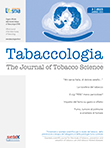|
Rassegna Stampa Scientifica Aprile 2022
|
Prohibition no, abolition yes! Rethinking how we talk about ending the cigarette epidemic
Tobacco Control Online issue publication March 03, 2022.
Ruth E Malone, Robert N Proctor
https://tobaccocontrol.bmj.com/node/163825.full
https://tobaccocontrol.bmj.com/content/tobaccocontrol/31/2/376.full.pdf
Note: Open Access.
"Recently advanced ethical arguments favouring the interests of people who currently smoke over those of young never-smokers fail to fully convince. Several of these arguments are constrained by a resource prioritisation framework that is neither appropriate to nor adequate for the analytical task, since ENDS [electronic nicotine delivery systems] are not a scarce resource for which we have to find the ethically best recipient. Arguments that assume ENDS are less harmful than combustible cigarettes, or the least restrictive alternative, do not adequately consider young never-smokers’ perspectives; ENDS will be more rather than less harmful and restrictive than no nicotine use at all for this group. Both the interests of those who smoke in reducing the risks they face and the interests of young people in avoiding nicotine dependence and protecting their health are weighty."
Ethics and ENDS
Tobacco Control Published Online First: 25 March 2022.
Elizabeth Fenton, Lindsay Robertson, Janet Hoek
https://tobaccocontrol.bmj.com/content/early/2022/03/24/tobaccocontrol-2021-057078
Note: Open Access.
"The data on e-cigarettes as an effective and safe harm reduction strategy for users of traditional combustible cigarettes, are complicated and often contradictory. Although there has been some recent evidence that supports the use of e-cigarettes for smoking cessation, there is also evidence that ENDS [electronic nicotine delivery systems] use may be associated with other worrisome behaviors. Use of e-cigarettes may persist after smoking cessation, cigarette use relapse may be a risk, dual use is common, and the full extent of risks is still largely unknown, especially with the frequent arrival of novel devices to the marketplace and vast variations in vape liquid, ingredients, and nicotine concentration… The risks posed by e-cigarettes are many, particularly to adolescents, who have skyrocketing rates of nicotine addiction, vulnerability to lung injury, potential impairment of cognitive function, and increased risk of traditional combustible cigarette use."
E-Cigarettes-a review of the evidence-harm versus harm reduction
Tob Use Insights. 2022 Mar 29;15:1179173X221087524. eCollection 2022.
Susan Feeney, Victoria Rossetti, Jill Terrien
https://www.ncbi.nlm.nih.gov/pmc/articles/PMC8968985/
https://www.ncbi.nlm.nih.gov/pmc/articles/PMC8968985/pdf/10.1177_1179173X221087524.pdf
Note: Open Access.
"Seven papers assessed perinatal outcomes following ENDS [electronic nicotine delivery systems] use during pregnancy. There was evidence that ENDS use was associated with increased risk for some adverse perinatal outcomes (e.g., small for gestational age). However, the repeated use of data sets, insufficient data (e.g., timing of ENDS use, type of ENDS products used), and limited samples size, contributed to mixed findings on the degree to which ENDS use (alone or in combination with combustible cigarettes (CC)) impacts the risk of adverse perinatal outcomes relative to CC smoking alone."
Electronic Nicotine Delivery Systems (ENDS) Use and Pregnancy II: Perinatal Outcomes Following ENDS Use During Pregnancy
Curr Addict Rep. 2021 Sep;8(3):366-379. Epub 2021 Jul 21.
Elise E DeVito, Tessa Fagle, Alicia M Allen, Raina D Pang, Nicole Petersen, Philip H Smith, Andrea H Weinberger
https://link.springer.com/article/10.1007/s40429-021-00381-9
"The main findings of this study are that: (1) Most physicians had HTP [heated tobacco product] awareness and agreed that there is a lack of evidence regarding their long-term safety. (2) Only half of the physicians discouraged HTP use in patients. (3) Only a few physicians believed that HTPs are useful as a conventional cigarette substitute. (4) Physicians’ smoking status and cessation behaviors largely affected their attitudes toward patients’ HTP use and concerns… Increasing evidence regarding HTPs’ health effects and educating physicians are critical first steps towards reducing tobacco-related deaths."
Awareness, Attitudes, and Concerns Regarding Heated Tobacco Products among Physicians in Japan
J Epidemiol. 2022 Apr 2. Online ahead of print.
Yuichiro Otsuka, Yoshitaka Kaneita, Osamu Itani, Yuuki Matsumoto, Yutaka Hatori, Satoshi Imamura
https://www.jstage.jst.go.jp/article/jea/advpub/0/advpub_JE20210470/_article
https://www.jstage.jst.go.jp/article/jea/advpub/0/advpub_JE20210470/_pdf/-char/en
Note: Open Access.
"In response to a ban of all added flavors for cigarettes or cigars, nearly half of current smokers would quit smoking, largely by switching to non-smoking products. However, smokers with more chronic use and those who used only menthol cigarettes would be more likely to switch to non-flavored smoking, diminishing the harm reduction potential. The ban may decrease the relatively higher prevalence of menthol cigarette smoking among Blacks compared with other groups."
How Smokers of Menthol Cigarettes and Flavored Cigars Might Respond to FDA’s Proposed Bans
Nicotine & Tobacco Research, ntac078.
Published: 30 March 2022
Yong Yang, Eric N Lindblom, Kenneth D Ward, Ramzi G Salloum
https://academic.oup.com/ntr/advance-article-abstract/doi/10.1093/ntr/ntac078/6556048
"During spring 2021, during the 30 days before the survey, approximately one in three high school students used any tobacco product, alcohol, or marijuana or engaged in prescription opioid misuse; one in six students used EVPs [electronic vapor products]… These findings are of public health concern because youths’ use of tobacco products in any form is unsafe; EVPs contain nicotine, which is highly addictive, can harm adolescent brain development, and can prime the brain for addiction to other drugs."
Use of Tobacco Products, Alcohol, and Other Substances Among High School Students During the COVID-19 Pandemic — Adolescent Behaviors and Experiences Survey, United States, January–June 2021
MMWR Supplements / April 1, 2022 / 71(3);8–15
Nancy D. Brener, Michele K. Bohm, Christopher M. Jones, Samantha Puvanesarajah, Leah Robin, Nicolas Suarez, Xiaoyi Deng, R. Lee Harding, Davia Moyse
https://www.cdc.gov/mmwr/volumes/71/su/su7103a2.htm
https://www.cdc.gov/mmwr/volumes/71/su/pdfs/su7103a2-H.pdf
Note: Open Access.
"Consistent with prior findings that MCII [mental contrasting with implementation intentions] works best in vulnerable populations, MCII may be more effective for smoking reduction among high-stress than low-stress individuals… The greater stress experienced by low-SES [socioeconomic status] individuals may have created a vulnerability to smoking that MCII, but not the active control, helped combat against."
Effectiveness of a Motivational Smoking Reduction Strategy Across Socioeconomic Status and Stress Levels
Front Psychol. 2022 Mar 18;13:801028. eCollection 2022.
Elizabeth C Voigt, Elizabeth R Mutter, Gabriele Oettingen
https://www.frontiersin.org/articles/10.3389/fpsyg.2022.801028/full
Note: Open Access.
"A total of 34 articles with 35,193 COVID-19 patients was included. The meta-analysis confirmed the association between current smoking (OR 1.26, 95% CI: 1.01-1.58) and former smoking (OR 1.76, 95% CI: 1.53-2.03) with COVID-19 mortality. We also found that the risk for COVID-19 death in current smokers does not vary by age, but significantly drops by age in former smokers… Conclusions: Current and former smokers are at higher risk of dying from COVID-19. Tobacco control should be strengthened to encourage current smokers to quit and prevent the initiation of smoking."
Active smokers are at higher risk of COVID-19 death: A systematic review and meta-analysis
Nicotine & Tobacco Research, ntac085.
Published: 01 April 2022
Roengrudee Patanavanich, Tanatorn Siripoon, Salin Amponnavarat, Stanton A Glantz
https://academic.oup.com/ntr/advance-article-abstract/doi/10.1093/ntr/ntac085/6562455
Also:
Youth vaping during the early stages of the COVID-19 pandemic period: adjusted annual changes in vaping between the pre-COVID and initial COVID-lockdown waves of the COMPASS study
https://academic.oup.com/ntr/advance-article/doi/10.1093/ntr/ntac083/6562769
Remote versus In-Person Learning During COVID-19: Comparison of E-Cigarette Susceptibility and Ever Use among a diverse cohort of 6 th Grade Students in Texas
https://academic.oup.com/ntr/advance-article/doi/10.1093/ntr/ntac084/6562770
Changes in Smoking Status and Behaviours After the First Ten Months of Covid-19 Pandemic in Indonesia
https://academic.oup.com/ntr/advance-article-abstract/doi/10.1093/ntr/ntac086/6562771
Exposure to negative news stories about vaping, and harm perceptions of vaping, among youth in England, Canada, and the US before and after the outbreak of E-cigarette or Vaping-Associated Lung Injury (EVALI)
https://academic.oup.com/ntr/advance-article/doi/10.1093/ntr/ntac088/6562888
Note: COMPASS, Remote versus In-Person Learning and EVALI papers Open Access.
"In this study, we found that serum anti-RBD [receptor-binding domain] IgG levels were negatively correlated with FTND [Fagerstrom Test for Nicotine Dependence] after BNT162b2 vaccination, while it showed no clear correlation with serum cotinine levels. These results suggest that repeated smoking behavior due to strong cigarette dependence may lead to low antibody titers after COVID-19 mRNA vaccination, and that the factors affecting low antibody titers after COVID-19 mRNA vaccination in cigarettes may not be limited to nicotine."
Antibody response of smokers to the COVID-19 vaccination: Evaluation based on cigarette dependence
Drug Discov Ther. 2022 Apr 4. Online ahead of print.
Yukihiro Mori, Mamoru Tanaka, Hana Kozai, Kiyoshi Hotta, Yuka Aoyama, Yukihiro Shigeno, Makoto Aoike, Hatsumi Kawamura, Masato Tsurudome, Morihiro Ito
https://www.jstage.jst.go.jp/article/ddt/advpub/0/advpub_2022.01022/_article
https://www.jstage.jst.go.jp/article/ddt/advpub/0/advpub_2022.01022/_pdf/-char/en
Note: Open Access.
"Nicotine replacement therapy and nicotine vaping products are two commonly used smoking cessation aids. This study demonstrates that misperceptions of the harms of nicotine products relative to cigarettes influence their use for smoking cessation. Believing that nicotine vaping products are much less harmful than cigarette smoking may lead some smokers to prefer these products over nicotine replacement therapy to aid smoking cessation."
Do smokers’ perceptions of the harmfulness of nicotine replacement therapy and nicotine vaping products as compared to cigarettes influence their use as an aid for smoking cessation? Findings from the ITC Four Country Smoking and Vaping Surveys
Nicotine & Tobacco Research, ntac087.
Published: 03 April 2022
Hua-Hie Yong, Shannon Gravely, Ron Borland, Coral Gartner, K Michael Cummings, Katherine East, Scott Tagliaferri, Tara Elton-Marshall, Andrew Hyland, Maansi Bansal-Travers, Geoffrey T Fong
https://academic.oup.com/ntr/advance-article/doi/10.1093/ntr/ntac087/6562889
Also:
Tobacco use and respiratory symptoms among adults: Findings from the Longitudinal Population Assessment of Tobacco and Health (PATH) Study 2014-16
https://academic.oup.com/ntr/advance-article/doi/10.1093/ntr/ntac080/6562762
Appropriate policy implications of the fact that high content and flavored e-cigarettes have higher abuse liability
https://academic.oup.com/ntr/advance-article/doi/10.1093/ntr/ntac089/6562583
Note: Open Access.
"Eight studies were included, seven were at high risk of bias. There was inconclusive evidence of the effect of MMCs [mass media campaigns] on quit attempts and intentions to quit among people with mental illness. Increasing advertisement exposure did not increase quit attempts or intentions to quit among those with mental illness, however, increased exposure to an advertisement that addressed smoking and mental health did. None of the studies assessed cost-effectiveness."
The effect of tobacco control mass media campaigns on smoking-related behaviour among people with mental illness: a systematic literature review
Nicotine & Tobacco Research, ntac079.
Published: 31 March 2022
Parvati R Perman-Howe, Ann McNeill, Leonie S Brose, Bernadett E Tildy, Tessa E Langley, Debbie Robson
https://academic.oup.com/ntr/advance-article/doi/10.1093/ntr/ntac079/6561788
Note: Open Access.
Also:
E-cigarette provision to promote switching in cigarette smokers with serious mental illness—a randomized trial
https://academic.oup.com/ntr/advance-article-abstract/doi/10.1093/ntr/ntac082/6562456
Failed Attempts to Quit Combustible Cigarettes and e-Cigarettes Among US Adolescents
JAMA. 2022;327(12):1179-1181.
March 22/29, 2022
Richard Miech, Adam M. Leventhal, Patrick M. O’Malley, Lloyd D. Johnston, Jessica L. Barrington-Trimis,
https://jamanetwork.com/journals/jama/article-abstract/2790303
Related PR:
E-cigarettes contribute to unsuccessful nicotine quit attempts by adolescents
"A multi-institutional retrospective study was performed by querying the electronic health records at nine children's hospitals… 15 children sustained traumatic injuries due to e-cigarette explosion. The median age was 17 y (range 13-18). The median injury severity score was 2 (range 1-5). Three patients reported that their injury coincided with their first vaping experience… The injuries sustained were: facial burns (6), loss of multiple teeth (5), thigh and groin burns (5), hand burns (4), ocular burns (4), a radial nerve injury, a facial laceration, and a mandible fracture. Six children required operative intervention, one of whom required multiple operations for a severe hand injury. Conclusions: In addition to vaping-associated lung injury, vaping-associated traumatic injuries are an emerging and worrisome injury pattern sustained by adolescents in the United States."
Adolescent Vaping-Associated Trauma in the Western United States
J Surg Res. 2022 Apr 5;276:251-255. Online ahead of print.
Katie W Russell, Micah G Katz, Ryan C Phillips, Lorraine I Kelley-Quon, Shannon N Acker, Niti Shahi, Justin H Lee, Elizabeth A Fialkowski, Deepthi Nacharaju, Caitlin A Smith, Aaron R Jensen, Claudia M Mueller, Benjamin E Padilla, Romeo C Ignacio, Shadassa Ourshalimian, Kasper S Wang, Daniel J Ostlie, Stephen J Fenton, Zachary J Kastenberg, Western Pediatric Surgery Research Consortium
https://www.journalofsurgicalresearch.com/article/S0022-4804(22)00095-6/fulltext
"The study sample consisted of 12,570 (weighted N = 23,993,149) individuals aged 12 to 17 years old. Unadjusted past 30-day exposure to newspaper, radio, billboard, and social media advertising all correlated with a reduced harm perception, but only the associations for newspaper and social media were statistically significant (p<0.05)… Conclusion: E-cigarette advertising influences adolescent perceptions of harm in e-cigarette use, particularly for social media and newspaper advertisements. This association weakens when adjusted for covariates such as environmental support and exposure to anti-tobacco marketing."
The association of adolescent e-cigarette harm perception to advertising exposure and marketing type
Arch Public Health. 2022 Apr 8;80(1):114.
Man Hung, Andrew Spencer, Clarissa Goh, Eric S Hon, Val Joseph Cheever, Frank W Licari, Ryan Moffat, Ben Raymond, Martin S Lipsky
https://archpublichealth.biomedcentral.com/articles/10.1186/s13690-022-00867-6
https://archpublichealth.biomedcentral.com/track/pdf/10.1186/s13690-022-00867-6.pdf
Note: Open Access.
"Most vapers in the UK and the US want to stop vaping (62% vs 61%; p=.9493), but US respondents plan to quit significantly sooner (OR 0.47, p=.0004). Attitudes differed as well. Over half (56%) of UK respondents reported their government approved e-cigarette use, and 24% felt health care providers had positive views on e-cigarettes versus 29% and 13% from the US, respectively (p=.0004 for both). Conclusions: Plans for quitting and perceptions regarding e-cigarettes differ markedly between demographically similar groups of vapers in the two countries."
Vaping, perceptions of vaping, and plans to quit among e-cigarette users in the United States and the United Kingdom
Nicotine & Tobacco Research, ntac092.
Published: 4 April 2022
Keith Feldman, Ligia Menezes do Amaral, Telmo Mota Ronzani, Kimber P Richter, Nathalia Munck Machado
https://academic.oup.com/ntr/advance-article-abstract/doi/10.1093/ntr/ntac092/6563383
"Adolescents rated the chemical, lung, and COVID-19 harms warning messages higher on PME [perceived message effectiveness] than nicotine addiction and control (all p<.05), while nicotine addiction was rated higher than control (p<.05). The chemical, lung, and COVID-19 harms warning themes also elicited greater negative affect than nicotine addiction and control (all p<.05). For all other secondary outcomes, the COVID-19 harms warning message theme was rated higher than nicotine addiction and control (all p<.05)… To discourage vaping, the FDA [Food & Drug Administration] and others should communicate to youth about the health effects of vaping beyond nicotine addiction."
Identifying promising themes for adolescent vaping warnings: A national experiment
Nicotine Tob Res. 2022 Apr 9;ntac093. Online ahead of print.
Jacob A Rohde, Seth M Noar, Jennifer Mendel Sheldon, Marissa G Hall, Talia Kieu, Noel T Brewer
https://academic.oup.com/ntr/advance-article-abstract/doi/10.1093/ntr/ntac093/6566012
"Prevalence of nicotine misperceptions was significantly higher-than-average among those who recognized all ten smoking-caused diseases (PR: 1.34), believed additive-free cigarettes were more harmful than regular cigarettes (PR: 1.71), or did not report subjective norms supporting noncombustible use (PR: 1.05). Conclusion: High perceived threat of tobacco may be overgeneralized to nicotine… Messaging should attempt to correct the misperception that nicotine causes cancer."
Beliefs and Characteristics Associated With Believing Nicotine Causes Cancer: A Descriptive Analysis to Inform Corrective Message Content and Priority Audiences
Nicotine & Tobacco Research, ntac060.
Published: 06 April 2022
Caitlin Weiger, Meghan Bridgid Moran, Ryan David Kennedy, Rupali Limaye, Joanna Cohen
https://academic.oup.com/ntr/advance-article-abstract/doi/10.1093/ntr/ntac060/6564285
"In this cohort study of 2.4 million adults, adjusting for socio-demographics and medical comorbidities, current cigarette smoking was associated with a lower risk of both COVID-19 infection and severe COVID-19 illness compared to never-smoking. A history of smoking was associated with a slightly lower risk of COVID-19 infection and a modestly higher risk of severe COVID-19 illness compared to never-smoking. The lower observed COVID-19 risk for current versus never-smoking deserves further investigation."
Cigarette Smoking and Risk of SARS-CoV-2 infection and Disease Severity Among Adults in an Integrated Health Care System in California
Nicotine & Tobacco Research, ntac090.
Published: 03 April 2022
Kelly C Young-Wolff, Natalie Slama, Stacey E Alexeeff, Lori C Sakoda, Renee Fogelberg, Laura C Myers, Cynthia I Campbell, Alyce S Adams, Judith J Prochaska
https://academic.oup.com/ntr/advance-article-abstract/doi/10.1093/ntr/ntac090/6562890
"Health officials [in Ethiopia, India, Uganda] typically link its core norm of a fundamental conflict between public health and industry interests to the governance norm of protecting public health policies from industry interference. While officials in sectors beyond health broadly endorsed this core norm, they exhibited more limited awareness of [Framework Convention on Tobacco Control] Article 5.3 and its model of governance. The results examine how rules to implement Article 5.3 have been codified, but identify the absence of policy tools necessary to operationalise rules and norms… Conclusion: Conceptualising Article 5.3 as a policy instrument helps to explain how its rules and policy tools interact with each other and with broader governance processes."
Norms, rules and policy tools: understanding Article 5.3 as an instrument of tobacco control governance
Tobacco Control Published Online First: 07 April 2022.
Rob Ralston, Selamawit Hirpa, Shalini Bassi, Denis Male, Praveen Kumar, Rachel Ann Barry, Jeff Collin
https://tobaccocontrol.bmj.com/content/early/2022/04/06/tobaccocontrol-2021-057159
Also:
Institutional tensions, corporate social responsibility and district-level governance of tobacco industry interference: analysing challenges in local implementation of Article 5.3 measures in Karnataka, India
https://tobaccocontrol.bmj.com/content/early/2022/04/06/tobaccocontrol-2021-057113
’A contradiction between our state and the tobacco company’: conflicts of interest and institutional constraints as barriers to implementing Article 5.3 in Bangladesh
https://tobaccocontrol.bmj.com/content/early/2022/04/06/tobaccocontrol-2021-057142
Note: Open Access.
"Most state-level policies (71.4%) were categorised in the second lowest comprehensiveness category; local policies most commonly fell within the lowest (48.9%) or highest (26.0%) comprehensiveness categories. Across jurisdictions, adult-only retailers were most frequently exempted from the FTP [flavoured tobacco product] sales restrictions (state: n=1, 14.3%; local: n=184, 56.3%); and most jurisdictions included electronic cigarettes (e-cigarettes) as a banned product (state: n=6, 87.5%; local: n=327, 100%). While just over half of state (n=4, 57.1%) and local (n=169, 51.7%) sales restrictions included menthol e-cigarettes, most excluded menthol cigarettes and/or menthol smokeless tobacco."
Classifying the comprehensiveness of flavoured tobacco sales restrictions: development and application of a tool to examine US state and local tobacco policies
Tobacco Control Published Online First: 17 December 2021.
Emily Donovan, Shanell Folger, Maham Akbar, Barbara Schillo
https://tobaccocontrol.bmj.com/content/early/2022/04/05/tobaccocontrol-2021-057042
Also:
Menthol versus non-menthol flavouring and switching to e-cigarettes in black and Latinx adult menthol combustible cigarette smokers: secondary analyses from a randomised clinical trial
https://tobaccocontrol.bmj.com/content/early/2022/03/28/tobaccocontrol-2021-057180
"Twenty RCTs [randomized controlled trials] involving 16,702 smokers were included. The risk of bias results showed that 10 RCTs were rated as high, three were low, and seven were unclear. A total of 21 pairs were compared based on seven interventions. The NMA [network meta-analysis] showed that, compared to the placebo (PLA), the other six interventions had significant efficacy in smoking cessation, where VAR [varenicline] + BUP [bupropion] showed the best effect of all treatments (odds ratio (OR) = 6.08, 95% confidence interval (CI) [3.47, 10.66]). Moreover, VAR + BUP was superior to VAR + NRT [nicotine replacement therapy] (OR = 1.66, 95% CI [1.07, 2.59]) and the three monotherapies (VAR, BUP, and NRT). In the monotherapies, the results of pairwise comparisons of VAR, BUP, and NRT did not show significant differences… Conclusions: The efficacy of VAR, BUP, and NRT alone increased the odds of smoking abstinence better than the placebo, combined interventions were superior to monotherapy, and VAR combined with other interventions had a better smoking cessation effect."
The effect of Varenicline and Bupropion on smoking cessation: A network meta-analysis of 20 randomized controlled trials
Addict Behav. 2022 Apr 5;131:107329. Online ahead of print.
Kangle Guo, Shizhong Wang, Xue Shang, Fenfen E, Liangying Hou, Jieyun Li, Yanfei Li, Kehu Yang, Xiuxia Li
https://www.sciencedirect.com/science/article/abs/pii/S0306460322000958
"Relative to 1 mg, 2 mg/day of Varenicline attenuated abstinence-induced increases in craving (TQSU [Tiffany Questionnaire for Smoking Urges] Factor 1 d=-0.47, p = .006; TQSU Factor 2 d=-0.42, p = .008) and withdrawal (MNWS [Minnesota Nicotine Withdrawal Scale] d=-0.35, p = .03) in both groups. Conclusion: Our preliminary findings suggest that subacute Varenicline treatment reduces abstinence-induced craving and withdrawal in participants with and without SCZ [schizophrenia]."
Dose-dependent effects of Varenicline on tobacco craving and withdrawal in tobacco smokers with and without schizophrenia
Drug Alcohol Depend. 2022 Mar 28;234:109412. Online ahead of print.
Samantha Johnstone, Maryam Sorkhou, Rachel A Rabin, Tony P George
https://www.sciencedirect.com/science/article/abs/pii/S0376871622001491
"COPD [Chronic Obstructive Pulmonary Disease] is among the most common chronic medical conditions in the United States, affecting over 26 million Americans. Data from the National Health and Nutrition Examination Survey III found that a typical 65-year-old patient with mild or moderate COPD has a life expectancy of over 10 years. This finding suggests a therapeutic window wherein robust screening tools and targeted clinical interventions would yield clinical benefits for patients with COPD. Furthermore, possibly an even greater population suffer from a spectrum of tobacco-related respiratory illness. Studies have suggested that use of tobacco, even in the absence of airflow obstruction, generates risk of impaired respiratory health. However, relatively few objective parameters exist in clinical practice for monitoring disease status and progression in this population. Identification of measurable and reversible risk factors that could intercept disease progression in this group would have significant impact on population health."
Intercepting Smoking-Related Respiratory Disease: Finding Novel Markers Beyond the Lung
Chest. 2022 Apr;161(4):867-868.
Joseph I Bailey, Ravi Kalhan
https://journal.chestnet.org/article/S0012-3692(21)05088-1/fulltext
https://journal.chestnet.org/action/showPdf?pii=S0012-3692%2821%2905088-1
Note: Open Access.
Related Chest study:
Longitudinal Association Between Muscle Loss and Mortality in Ever Smokers
https://journal.chestnet.org/article/S0012-3692(21)04290-2/fulltext
"Among the 73,205 newborns enrolled, multivariable analysis revealed that the aOR (95% CI) of LRTI [lower respiratory tract infection] and GI [gastroenteritis] was 1.20 (1.07-1.33) and 1.18 (1.04-1.35), respectively, for the "Current smoker with/without SHS" [secondhand smoke] group compared with the "Never smoked without SHS" group. "Quit smoking without SHS" was not associated with the risk of LRTI. SHS was associated with an increased risk of OM [otitis media], URTI [upper respiratory tract infection], LRTI, and GI, especially with LRTI and GI."
Tobacco Exposure During Pregnancy and Infections in Infants up to 1 Year of Age: The Japan Environment and Children's Study
J Epidemiol. 2022 Apr 9. Online ahead of print.
Koichi Hashimoto, Hajime Maeda, Hajime Iwasa, Hyo Kyozuka, Ryo Maeda, Yohei Kume, Takashi Ono, Mina Chishiki, Akiko Sato, Yuka Ogata, Tsuyoshi Murata, Keiya Fujimori, Kosei Shinoki, Hidekazu Nishigori, Seiji Yasumura, Mitsuaki Hosoya, Japan Environment and Children’s Study (JECS) Group
https://www.jstage.jst.go.jp/article/jea/advpub/0/advpub_JE20210405/_article
https://www.jstage.jst.go.jp/article/jea/advpub/0/advpub_JE20210405/_pdf/-char/en
Note: Open Access.
"A series of tobacco control programs: advocacy, health education, brief interventions for smoking cessation, peer counselor training, media campaigns, and policy regulations were implemented… Majority of smokers (76.6%) reduced their consumption, and 5.6% of them quit smoking. Among smokers, we found that attitude toward smoking cessation, subjective norm, and perceived control for quitting were related to the intention to stop smoking."
A Comprehensive Tobacco Control Policy Program in a Mining Industry in Indonesia: Did It Work?
Front Public Health. 2022 Mar 24;10:853862. eCollection 2022.
Yayi S Prabandari, Bagas S Bintoro, Purwanta Purwanta
https://www.frontiersin.org/articles/10.3389/fpubh.2022.853862/full
Note: Open Access.
"Smokers presented high levels of hostility and those who smoke more than 15 cigarettes per day indicated higher levels of anxiety than those who smoke less or not at all. Lower levels of empathy appeared in smokers, regardless of occupation. Smokers presented lower levels of annoyance when they are in a place where smoking is prohibited and someone else smokes. Participants with higher somatization, hostility, and lower empathy are less bothered when they are in a place where smoking is prohibited and someone else smokes."
Assessment of Greek Smokers' Psychological Characteristics and Empathy While Smoking in Enclosed Public Spaces and Near Nonsmokers
Cureus. 2022 Mar 7;14(3):e22910. eCollection 2022 Mar.
Giorgos Iatrou, Konstantinos I Gourgoulianis, Evangelia Kotrotsiou, Mary Gouva
https://assets.cureus.com/uploads/original_article/pdf/85751/20220406-24101-1p0j3da.pdf
Note: Open Access upon registration.
The Tobacco Wars’ Lessons for the Vaccination Wars
NEJM April 13, 2022
Robert Bazell, Howard Koh, and Barry R. Bloom
https://www.nejm.org/doi/full/10.1056/NEJMp2202618
Note: Open Access.
"Adolescents rated the chemical, lung, and COVID-19 harms warning messages higher on PME [perceived message effectiveness] than nicotine addiction and control (all p<.05), while nicotine addiction was rated higher than control (p<.05). The chemical, lung, and COVID-19 harms warning themes also elicited greater negative affect than nicotine addiction and control (all p<.05). For all other secondary outcomes, the COVID-19 harms warning message theme was rated higher than nicotine addiction and control (all p<.05)."
Identifying promising themes for adolescent vaping warnings: A national experiment
Nicotine & Tobacco Research, ntac093.
Published: 09 April 2022
Jacob A Rohde, Seth M Noar, Jennifer Mendel Sheldon, Marissa G Hall, Talia Kieu, Noel T Brewer
https://academic.oup.com/ntr/advance-article-abstract/doi/10.1093/ntr/ntac093/6566012
"There is no evidence in the full sample [of 1034 UK children aged 13–17 years] to suggest that children’s susceptibility to smoking is increased by exposure to higher visibility e-cigarette retail displays, or to a higher proportion of e-cigarette images. However, for regular store visitors or those paying more attention, viewing a higher proportion of e-cigarette images increased susceptibility to smoking. In addition, viewing higher visibility e-cigarette images reduced perceived harm of smoking."
Impact of e-cigarette retail displays on attitudes to smoking and vaping in children: an online experimental study
Tobacco Control Published Online First: 13 April 2022.
Anna K M Blackwell, Mark A Pilling, Katie De-Loyde, Richard W Morris, Laura A Brocklebank, Theresa M Marteau, Marcus R Munafò
https://tobaccocontrol.bmj.com/content/early/2022/04/13/tobaccocontrol-2021-056980
Also:
Public health impact of a US ban on menthol in cigarettes and cigars: a simulation study
https://tobaccocontrol.bmj.com/content/early/2022/04/13/tobaccocontrol-2021-056604
Note: Open Access.
"Counties with greater implementation of flavoured tobacco product restrictions were associated with a decrease in the level of cigarette use among users (Coefficient −1.56; 95% CI −2.54 to −0.58). A significant interaction (p=0.03) revealed the largest reductions among 14 and 18 year olds. Increasing flavoured tobacco product restrictions were also associated with reductions in the likelihood of e-cigarette use (Coefficient −0.87; 95% CI −1.68 to −0.06). Increasing tobacco 21 restrictions were associated with decreases in cigarette use only among 18 year olds, while there was no evidence of associations between smoke-free laws with use of either tobacco product."
Flavoured tobacco product restrictions in Massachusetts associated with reductions in adolescent cigarette and e-cigarette use
Tobacco Control Published Online First: 27 January 2021.
Summer Sherburne Hawkins, Claudia Kruzik, Michael O'Brien, Rebekah Levine Coley
https://tobaccocontrol.bmj.com/content/early/2022/04/14/tobaccocontrol-2020-056159
Also:
Nicotine pouch product awareness, interest and ever use among US adults who smoke, 2021
https://tobaccocontrol.bmj.com/content/early/2022/04/10/tobaccocontrol-2021-057156
"Our findings reveal that time spent socializing in the virtual sphere is significantly associated with a greater likelihood of vaping nicotine, marijuana, and flavor. In addition, our findings reveal that while the relationship between virtual socializing and vaping is attenuated by unstructured socializing (i.e., unsupervised socializing or "hanging out") in person to some degree, time spent socializing virtually is still a significant predictor of adolescent vaping activity even after taking time spent socializing in person into account."
The role of virtual socializing and unstructured socializing in adolescent vaping
Drug Alcohol Depend. 2022 Apr 8;235:109446. Online ahead of print.
Cashen M Boccio, Wanda E Leal, Dylan B Jackson
https://www.sciencedirect.com/science/article/abs/pii/S0376871622001831
"We conducted a secondary analysis 65,565 enrolments in a large smoking cessation program in Ontario, Canada… From the start of the pandemic in March, 2020, total weeks of NRT [nicotine replacement therapy] provided rose significantly and then declined, while the amount of counseling fell. Associations between NRT use and participant characteristics changed significantly after the pandemic onset. Individual models showed that people with lower income, living in areas of higher marginalization, unable to work, and reporting higher levels of depressive symptoms all received NRT for a longer time during the pandemic period."
Effects of COVID-19-related disruptions on service use in a large smoking-cessation program
Nicotine & Tobacco Research, ntac103.
Published: 14 April 2022
Scott Veldhuizen, Newsha Mahinpey, Laurie Zawertailo, Nadia Minian, Osnat Melamed, Peter Selby
https://academic.oup.com/ntr/advance-article/doi/10.1093/ntr/ntac103/6568533
Also:
The Consequences of the COVID-19 Pandemic on Smoking Behaviour: Evidence from the English Longitudinal Study of Ageing
https://academic.oup.com/ntr/advance-article/doi/10.1093/ntr/ntac097/6568175
Tobacco-free nicotine pouch use in Great Britain: a representative population survey 2020–2021
https://academic.oup.com/ntr/advance-article/doi/10.1093/ntr/ntac099/6568313
Note: Open Access.
"In this cross-sectional survey of 2058 respondents, physicians who were asked about e-cigarettes by their patients, endorsed a harm-reduction perspective, or had ever smoked were more likely to recommend e-cigarettes to patients. In hypothetical clinical scenarios, physicians were more likely to recommend e-cigarettes for an older heavy smoker with prior unsuccessful quit attempts and use of pharmacotherapy for a younger light smoker with no prior cessation treatments."
Communication Between US Physicians and Patients Regarding Electronic Cigarette Use
JAMA Netw Open. 2022;5(4):e226692.
April 15, 2022
Cristine D. Delnevo, Michelle Jeong, Arjun Teotia, Michelle M. Bover Manderski, Binu Singh, Mary Hrywna, Olivia A. Wackowski, Michael B. Steinberg
https://jamanetwork.com/journals/jamanetworkopen/fullarticle/2791164
Note: Open Access.
Related PR:
Many physicians have misconceptions about e-cigarettes
https://www.eurekalert.org/news-releases/949619
"Bans of menthol characterizing flavor have been proposed, however the effects on menthol cigarette smokers of including e-cigarettes in such bans are not clear. This study found that smokers randomized to a simulated ban on menthol in both cigarettes and e-cigarettes smoked more cigarettes per day over the 6-week study period than those randomized to a simulated ban on menthol in only cigarettes suggesting that smoking patterns among current menthol smokers differ depending on which products are included in a menthol ban."
Effect on Tobacco Use and Subjective Measures of Including E-cigarettes in a Simulated Ban of Menthol in Combustible Cigarettes
Nicotine Tob Res. 2022 Apr 17;ntac107. Online ahead of print.
Michael Kotlyar, Ryan Shanley, Sheena R Dufresne, Gretchen A Corcoran, Dorothy K Hatsukami
https://academic.oup.com/ntr/advance-article-abstract/doi/10.1093/ntr/ntac107/6569416
"Of on-license premises, 6.5% (95% CI: 5.3, 8.0) sold tobacco; 17.4% (95% CI: 14.0, 21.4) of hotels, 17.5% (95% CI: 13.8, 21.9) of taverns, and 1.3% (95% CI: 0.6, 3.2) of restaurants. Both retailer type and population density were associated with selling status… Few on-license premises in NZ [New Zealand] sell tobacco. Most retailers would support transitioning out of selling tobacco before the 2025 Smokefree goal, and they believed ending sales of tobacco would not negatively impact their business. However, businesses and customers in rural areas may be more affected than others."
Could we see the end of tobacco being sold in bars and pubs in New Zealand?
Nicotine & Tobacco Research, ntac094.
Published: 13 April 2022
Louise Marsh, Ella Iosua, Robin Quigg, Julia Brillinger, Noeleen Venter, Sarah Wood
https://academic.oup.com/ntr/advance-article-abstract/doi/10.1093/ntr/ntac094/6568168
"Ads across all tobacco products included price incentives (96%) and contained themes that appealed to rural white (40%) and black audiences (15%). Themes known to appeal to youth and young adults were present in 40% of ads across all products, including 78% of ads promoting electronic nicotine delivery systems (ENDS). Moreover, among the ENDS ads featuring youth appealing themes (51%), also featured young models… Our findings highlight the need for regulations to address 1) the high prevalence of price incentives which undermine the effectiveness of excise taxes on tobacco use, and 2) ad themes and characteristics that appeal to groups vulnerable to tobacco use, both of which have the potential to further exacerbate tobacco related health disparities."
A content analysis of promotional features in US direct-mail from ads across tobacco products from 2018-2020
Nicotine & Tobacco Research, ntac095.
Published: 13 April 2022
Nathan Silver, Basmah Rahman, Shanell Folger, Adrian Bertrand, Bushraa Khatib, Macred Gbenro, Barbara Schillo
https://academic.oup.com/ntr/advance-article-abstract/doi/10.1093/ntr/ntac095/6568169
Also:
Tobacco Use among Gender-Varying and Gender-Stable Adolescents and Adults Living in the U.S
https://academic.oup.com/ntr/advance-article-abstract/doi/10.1093/ntr/ntac098/6568314
"We found an increase in the frequency of single-nucleotide variants and small insertions and deletions with chronological age in never-smokers, with mutation frequencies significantly elevated among smokers. When plotted against smoking pack-years, mutations followed the linear increase in cancer risk until about 23 pack-years, after which no further increase in mutation frequency was observed, pointing toward individual selection for mutation avoidance. Known lung cancer-defined mutation signatures tracked with both age and smoking."
Single-cell analysis of somatic mutations in human bronchial epithelial cells in relation to aging and smoking
Nature Genetics volume 54, pages492–498 (2022)
Published: 11 April 2022
Zhenqiu Huang, Shixiang Sun, Moonsook Lee, Alexander Y. Maslov, Miao Shi, Spencer Waldman, Ava Marsh, Taha Siddiqui, Xiao Dong, Yakov Peter, Ali Sadoughi, Chirag Shah, Kenny Ye, Simon D. Spivack & Jan Vijg
https://www.nature.com/articles/s41588-022-01035-w
Related PR:
Study suggests why most smokers don't get lung cancer
https://www.sciencedaily.com/releases/2022/04/220411113733.htm
Why Do Some Smokers Never Get Lung Cancer?
https://consumer.healthday.com/b-4-13-why-do-some-smokers-never-get-lung-cancer-2657122191.html
"We conducted a systematic review and meta-analysis of published data that evaluated an association between cigarette smoking and risk of SPC [second primary cancer]… In a meta-analysis using six studies, an increased risk of smoking-related SPC was observed for both former (RR[relative risk]=1.42; 95% confidence interval (CI) 1.20–1.67) and current smoking (RR=2.76; 95% CI 2.29–3.33), compared with never smoking… A two-fold increase in risk was observed for ever smoking compared with never smoking. In conclusion, there was evidence that smoking might increase the risk of SPC in cancer survivors."
Cigarette smoking and risk of second primary cancer: a systematic review and meta-analysis
Cancer Epidemiol. 2022 Apr 14;78:102160. Online ahead of print.
Zhi Jing Phua, Robert J MacInnis, Harindra Jayasekara
https://www.sciencedirect.com/science/article/abs/pii/S1877782122000650
"Exposure to secondhand smoke and secondhand aerosol was reported by 60.6% (95% CI=58.7, 62.4) and 44.5% (95% CI=42.1, 46.9) of U.S. youth, respectively. Among all students, 37.6% (95% CI=36.0, 39.2) and 53.3% (95% CI=51.4, 55.2) reported indoor and outdoor secondhand smoke exposure, respectively; 34.9% (95% CI=32.9, 37.4) and 36.8% (95% CI=34.6, 38.9) reported indoor and outdoor secondhand aerosol exposure, respectively. After adjustment, female versus male students (adjusted prevalence ratio=1.15-1.30) and those who currently use versus do not use combustible tobacco products (adjusted prevalence ratio=1.15-1.36) were more likely to report exposure to all outcomes."
Youth Indoor and Outdoor Exposure to Secondhand Smoke and Secondhand Aerosol
Am J Prev Med. 2022 Apr 5;S0749-3797(22)00048-4. Online ahead of print.
Samantha Puvanesarajah, James Tsai, Dayna S Alexander, Michael A Tynan, Andrea S Gentzke
https://www.ajpmonline.org/article/S0749-3797(22)00048-4/fulltext
https://www.ajpmonline.org/action/showPdf?pii=S0749-3797%2822%2900048-4
Note: Open Access.
"After adjustment for confounders, the estimated probability of surviving from age 65 to 85 years was 19 percentage points higher for persons with at least $300 000 in wealth (70%) than for those with no assets (51%), but there was a much larger 37 percentage point differential between never smokers (70%) and current smokers (33%)… Health care practitioners cannot modify their patient’s wealth, but they should continue to discourage smoking. Wealth may be associated with longevity, but just don’t smoke."
Assessment of Mortality Disparities by Wealth Relative to Other Measures of Socioeconomic Status Among US Adults
JAMA Netw Open. 2022;5(4):e226547.
April 8, 2022
Dana A. Glei, Chioun Lee, Maxine Weinstein
https://jamanetwork.com/journals/jamanetworkopen/fullarticle/2790904
Note: Open Access.
Related PR:
Smoking reduces wealth's tendency to increase life expectancy
https://www.sciencedaily.com/releases/2022/04/220415112150.htm
"Among the six tobacco control measures (monitoring tobacco use, protecting people from tobacco smoke, quitting tobacco, warning about the dangers of tobacco, enforcing bans on tobacco advertising, promotion and sponsorship, and raising taxes on tobacco) proposed in 2008, Japan has made no achievements in enforcing the advertisement ban. Consequently, tobacco advertisements still persistently appear in mass media, rendering the marketing strategies of tobacco companies in self-regulating their ads inefficient . People have no choice but to come across the ads, even if they wish to avoid them for children. However, it is not too late for Japan to follow the footsteps of Switzerland and other 164 countries."
Japan's position in the global standard to ban tobacco advertising in the media
J Epidemiol. 2022 Apr 16. Online ahead of print.
Masao Ichikawa, Takahiro Tabuchi
https://www.jstage.jst.go.jp/article/jea/advpub/0/advpub_JE20220074/_article
https://www.jstage.jst.go.jp/article/jea/advpub/0/advpub_JE20220074/_pdf/-char/en
Note: Open Access.






















